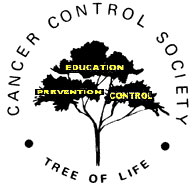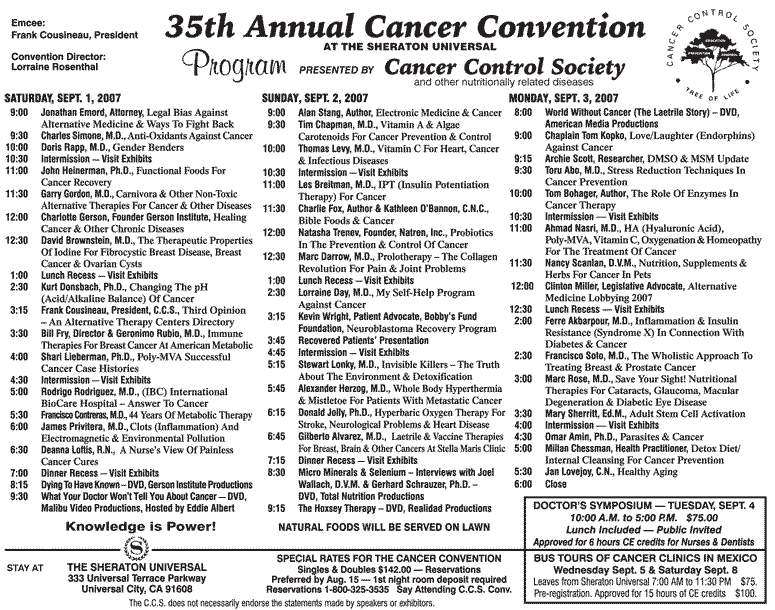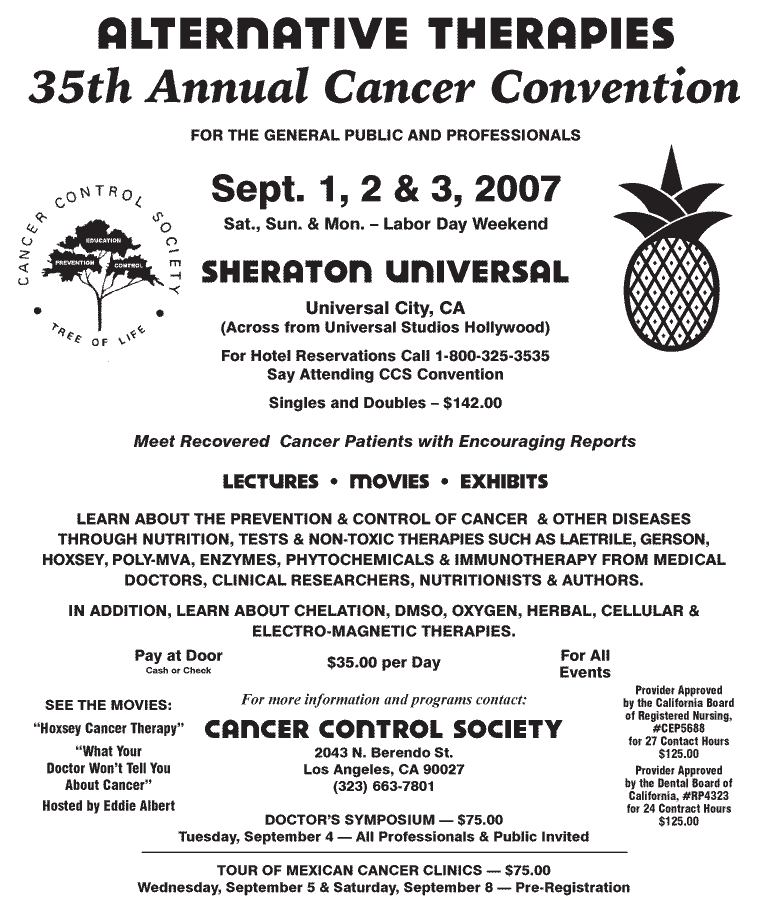Report on the Cancer Control Conference
by Siegfried Othmer | September 12th, 2007 One of the virtues of living in Los Angeles is that interesting conferences come to visit. I had occasion recently to attend the 35th annual meeting of the Cancer Control Society. It was illuminating to see one of these meetings from the perspective of an outsider.
One of the virtues of living in Los Angeles is that interesting conferences come to visit. I had occasion recently to attend the 35th annual meeting of the Cancer Control Society. It was illuminating to see one of these meetings from the perspective of an outsider.
Here we had yet another meeting of professionals who were largely sitting outside of the monolith of medicine—outside of the “medical monopoly” in cancer treatment of “poison, carve, or burn.” The mostly-MD speakers did not mince words. The flavor was a bit like the DAN Think Tank (Defeat Autism Now), and the American Academy of Pain Management, which are also populated by disaffected MDs. Everywhere there are rogue MDs looking for organizational frameworks where their creativity can be expressed; where they can escape the strictures of mainstream practice.
It had already been my impression that we are on the cusp of major breakthroughs in cancer treatment, and here it became clear that that has already been happening. The process has been under way, apparently, for some 35 years already. I picked up some literature dating back to the seventies just to see what current ideas can be traced back that far.
By now, of course, some of erstwhile radical ideas are already seeping into mainstream thinking. The late Martin Abeloff, chief oncologist at Johns Hopkins, acknowledged recently that “[cancer] therapies have been lengthy, toxic, and disfiguring, adding to the amount of suffering that a patient and family endures.” He recently urged colleagues not to overlook prevention–a substantial shift from the day that the cancer community was totally hostile to the idea that what we eat, the environment at large, and how we live our lives had anything to do with cancer at all. Finally, he has acknowledged that “you simply cannot treat cancer without paying attention to the psychological and social aspects of the disease.” These are all remarkable statements, and they have all flowed from the alternative world into mainstream thinking.
One speaker pointed out that cancer treatment has one clear advantage over cardiac care. When fate knocks at the door, there is still time to do something. By contrast, the first clear indication of heart trouble may already be fatal. But one shouldn’t push one’s luck. The technical program concerned itself with prevention as well as cure (although I heard that word used only once, and even then it was accompanied with an apology).
On the prevention side we encountered all of the usual lifestyle factors. Since most of the people drawn to this organization have had a brush with cancer personally, there was more than the usual fervor and urgency with regard to cleaning up the diet; attending to good gut function; tackling the sources of toxicity in our lives to support good and balanced immune and endocrine function; ramping up physical exercise; managing stress; and tending to the spiritual dimension of life. For these folks who had confronted their own mortality, none of these were casual concerns. Many had been through what was essentially a conversion experience, quite commonly with a religious or at least spiritual aspect, and they were now possessed of the expected missionary zeal.
Lorraine Day, an MD who had made the transition from the center of the mainstream as an orthopedic surgeon to the fringe by way of her own near-death encounter with breast cancer, said that the cancer was the best thing that ever happened to her. (In her case, incidentally, she went very public with her unorthodox recovery after unsuccessful treatment at Loma Linda, to the point where Loma Linda sent out a press release saying that she had never actually been diagnosed with cancer. The evidence to the contrary, however, was in her hands, and with legal help she compelled Loma Linda into a formal retraction. The hospital’s position was simply absurd. This just shows the desperate lengths to which mainstream practitioners will go to discredit alternatives. And just to seal the case with her audience, the doc showed us pictures of her cancer, which grew from a lump the size of a raisin to the size of an orange in a period of three weeks. Such tumor growth is never benign.
On the prevention side, one particular talk impressed me greatly. It was on the topic of iodine, by David Brownstein, author of the book titled simply “Iodine.” I highlight it here because we may well be dealing with another of these “universal truths,” namely that nearly the whole population is likely somewhat deficient in iodine. More than 90% of Brownstein’s patients fit into that category.
The dietary need for iodine was recognized nearly two hundred years ago, but it took nearly a hundred years before iodine was added to table salt. Over the last thirty years our dietary intake of iodine has dropped by 50%. This is due partly to the depletion of soils and our methods of agriculture. It is partly due to our reduced salt intake because of fears of hypertension. And on top of that came policies that compounded the problem.
Iodine was used for a long time in bread making to reduce the caking of the batter. The resulting iodine dose that people were getting exceeded the RDA, however, which was a concern simply because people varied so much in terms of how much bread they ate. So the FDA caused the iodine to be replaced by a bromine compound. Bromine, however, competes with iodine chemically in our bodies, displacing iodine. So we may actually be causing our iodine deficiency by way of our own policies. Additionally, the iodine in salt turns out to be a lot less “bio-available” than the iodine that used to be in bread.
The deficiency in iodine historically showed up in high incidence of goiter among school children in the Midwest, where soils are low in iodine. It was particularly a problem among pubescent girls because breast development competes for iodine with the thyroid. The incidence of goiter had been greater than 50% for this subgroup in one school district. With iodine supplementation of salt, we are past such crises. But other problems may be more covert. It could be that a lot of the thyroid issues we’re encountering these days is connected with the iodine depletion, which may also help to account for our escalating incidence of fibrocitis and the rising incidence of prostate and breast cancers.
Now iodine is not like Vitamin C, where one can just pile it on almost arbitrarily. There are hazards of too much iodine. But a substantial multiple of the accepted RDA is well tolerated by all. The RDA was driven by the issue of avoidance of goiter, not optimization of health status. A modest increase in dosage may be all that is called for in the absence of overt distress, and in the latter case on should of course proceed with medical guidance. Thyroid conditions in particular can be notoriously difficult to manage well. In higher dosages, iodine can also serve to detox bromine and fluorine, its chemical cousins. In any event, a bit of attention to iodine could potentially have a huge health impact on the population right where some of our methods are falling short.
Another substance for which we may be experiencing population-wide deficits around the world is Vitamin D3. It has been estimated that major inroads (perhaps on the order of 20%) could be made into our current cancer incidence with the mere expedient of increasing D3 levels in the population. This would have particular impact on colorectal and breast cancers, where the current trends are still unfavorable. This can be accomplished with a combination of supplementation and more sunlight on the skin. The problem arises partly from sun avoidance that was sparked by concern about skin cancers, particularly with the thinning of the ozone layer.
A doubling or tripling of the average blood level of D3 is expected to suffice to yield the expected gains. This can be accomplished with a mere 10-15 minutes of sun exposure if some 40% of skin surface is exposed.
Other news on the detox front related to various means of scavenging the heavy metals. Heavy doses of iodine/iodide can play a role here as well. Chelation can now be done with oral administration, and one does not have to be in a hurry about it. Detoxication is also an opportunity for retoxification. So outside of a medical setting one can proceed more slowly with the process, and even incorporate this into a steady-state regimen if necessary. Then there is Xeolite, which scavenges certain molecules. On the anti-oxidant front, we were reminded of good old Vitamin C, but also of the necessity of complementing that with the other anti-oxidants such as CoQ-10 and the E-vitamins. The carotenoids (Vitamin A among them) were discussed as well.
On the cancer suppression side, there were presentations on innovative techniques such as using insulin to convey chemo agents directly to the cancer target cells. Apparently the latter have some sixteen times as many insulin receptors as normal cells because of their voracious appetite for glucose. Using the insulin-push technique the chemo dose can be reduced to some 15% of normal, avoiding essentially all side effects.
There were talks on hyperbaric oxygen, hyperthermia, and the use of mistletoe as a chemo agent. Apparently Vitamin C can be used at such high dosages that it serves as a chemo agent also. And the reader may be surprised to find that Laetrile is still very much with us. (In this audience, it is referred to as Vitamin B17. One doesn’t actually have to know the right answer here. Surely there is nothing wrong with the consumption of an occasional apricot seed…. The cyanide is not enough to be harmful, and it does not accumulate in the body.) The discrediting of Laetrile decades ago only succeeded in driving it underground.
Underground in this case means medical clinics in Tijuana, Mexico, among other things. Buses run down there routinely to show prospective patients around. The operations are quite state-of-the-art, apparently, but conveniently out of the reach of the FDA. No one gave statistics on recovery, and I was not surprised. These clinics see many end-stage patients whose bodies are now a ravaged and depleted battlefield, with few resources of recovery. But these docs shared the attitude that we have developed in our own work, which is to expect success. In fact, people were encouraged to fire any of their docs who were not obviously part of a success-oriented healing agenda.
The conference also led to a clash of cultures of sorts. At the time of the meeting the conference hotel was also hosting a raft of children with cancer who were given an outing to the sights of Los Angeles on this Labor Day weekend. These children expressed an obvious interest in the exhibit halls, where they were confronted with bunches of people who didn’t think too highly of the conventional therapies the kids were undergoing, and who did not hesitate to tell them. The quality of discourse is of course a lot lower in the exhibit halls than on the program. All sorts of healing arts were represented there. The exhibits made for almost a bazaar type of atmosphere. Booths were set up in every available space, it seemed. Between the juicers, the purveyors of low-glycemic chocolate, the supplement offerings, and the oatmeal cookies one could probably have sustained life without leaving the room….
In summary, we seem to be hearing essentially the same story everywhere we go. We no longer get what we need from the food we eat. Supplementation is now a fact of life. We live in a toxic environment, and our bodies have become essentially toxic repositories. (Mother’s milk, for example, is no longer the unalloyed blessing that it was in the days when medicine spurned it. A number of organic toxins are given one more level of concentration, just as we are seeing with mercury in fish. The issue used to be DDT, and now it is dioxin, PCB’s, and PBDE’s.)
The biological systems that are most sensitive are the first to show the effects: autistic and asthmatic children, fibromyalgia and chronic fatigue patients, and the aging population. And in the background of it all is our issue: the quality of the regulatory apparatus, and hence of brain function. For us, the sensitive population consists largely of those who have a history of physical or psychological trauma. The missing piece for each of these populations is a direct approach to the quality of brain function: EEG feedback.







